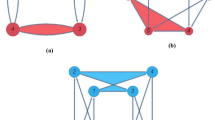Abstract
In this paper we study the relation between pyramid partitions with a general empty room configuration (ERC) and the BPS states of D-branes on the resolved conifold. We find that the generating function for pyramid partitions with a length n ERC is exactly the same as the D6/D2/D0 BPS partition function on the resolved conifold in particular Kähler chambers. We define a new type of pyramid partition with a finite ERC that counts the BPS degeneracies in certain other chambers.
The D6/D2/D0 partition functions in different chambers were obtained by applying the wall crossing formula. On the other hand, the pyramid partitions describe T 3 fixed points of the moduli space of a quiver quantum mechanics. This quiver arises after we apply Seiberg dualities to the D6/D2/D0 system on the conifold and choose a particular set of FI parameters. The arrow structure of the dual quiver is confirmed by computation of the Ext group between the sheaves. We show that the superpotential and the stability condition of the dual quiver with this choice of the FI parameters give rise to the rules specifying pyramid partitions with length n ERC.
Similar content being viewed by others
References
Denef, F., Moore, G.W.: Split states, entropy enigmas, holes and halos. http://arXiv.org/abs/hep-th/0702146v2, 2007
Kontsevich, M., Soibelman, Y.: Stability structures, motivic Donaldson-Thomas invariants and cluster transformations. http://arXiv.org/abs/0811.2435v1[math.AG], 2008
Iqbal A., Nekrasov N., Okounkov A., Vafa C.: Quantum foam and topological strings. JHEP 0804, 011 (2008)
Maulik, D., Nekrasov, N., Okounkov, A., Pandharipande, R.: Gromov-Witten theory and Donaldson-Thomas theory, I. http://arXiv.org/abs/math/0312059v3[math.AG], 2004; Gromov-Witten theory and Donaldson-Thomas theory, II. http://arXiv.org/abs/math/0406092v2[math.AG], 2005
Szendrői B.: Non-commutative Donaldson-Thomas theory and the conifold. Geom. Topol. 12, 1171–1202 (2008)
Young, B.: Computing a pyramid partition generating function with dimer shuffling. http://arXiv.org/abs/0709.3079v2[math.CO], 2008
Jafferis, D.L., Moore, G.W.: Wall crossing in local Calabi Yau manifolds. http://arXiv.org/abs/0810.4909v1[hep-th], 2008
Klebanov I.R., Witten E.: Superconformal field theory on threebranes at a Calabi-Yau singularity. Nucl. Phys. B 536, 199 (1998)
Jafferis, D.L.: Topological Quiver Matrix Models and Quantum Foam. http://arXiv.org/abs/0705.2250v1[hep-th], 2007
King, A.: Moduli of representations of finite-dimensional algebras. Quart. J. Math. Oxford Ser. 2,45, no. 180, 515–530 (1994)
Denef F.: Supergravity flows and D-brane stability. JHEP 0008, 050 (2000)
Ginzburg, V.: Calabi-Yau algebras. http://arXiv.org/abs/math/0612139v3[math.AG], 2007
Aspinwall P.S., Katz S.H.: Computation of superpotentials for D-Branes. Commun. Math. Phys. 264, 227 (2006)
Griffiths P., Harris J.: Principles of Algebraic Geometry. Wiley-Interscience, New York (1978)
Hartshorne R.: Algebraic Geometry. Springer, Berlin-Heidelberg-New York (1997)
Berenstein, D., Douglas, M.R.: Seiberg duality for quiver gauge theories. http://arXiv.org/abs/hep-th/0207027v1, 2002
Young, B., with an appendix by Bryan, J.: Generating functions for colored 3D Young diagrams and the Donaldson-Thomas invariants of orbifolds. http://arXiv.org/abs/0802.3948v2[math.CO], 2008
Nagao, K., Nakajima, H.: Counting invariant of perverse coherent sheaves and its wall-crossing. http://arXiv.org/abs/0809.2992v3[math.AG], 2008
Nagao, K.: Derived categories of small toric Calabi-Yau 3-folds and counting invariants. http://arXiv.org/abs/0809.2994v3[math.AG], 2008
Author information
Authors and Affiliations
Corresponding author
Additional information
Communicated by N. A. Nekrasov
Rights and permissions
About this article
Cite this article
Chuang, Wy., Jafferis, D.L. Wall Crossing of BPS States on the Conifold from Seiberg Duality and Pyramid Partitions. Commun. Math. Phys. 292, 285–301 (2009). https://doi.org/10.1007/s00220-009-0832-2
Received:
Accepted:
Published:
Issue Date:
DOI: https://doi.org/10.1007/s00220-009-0832-2



